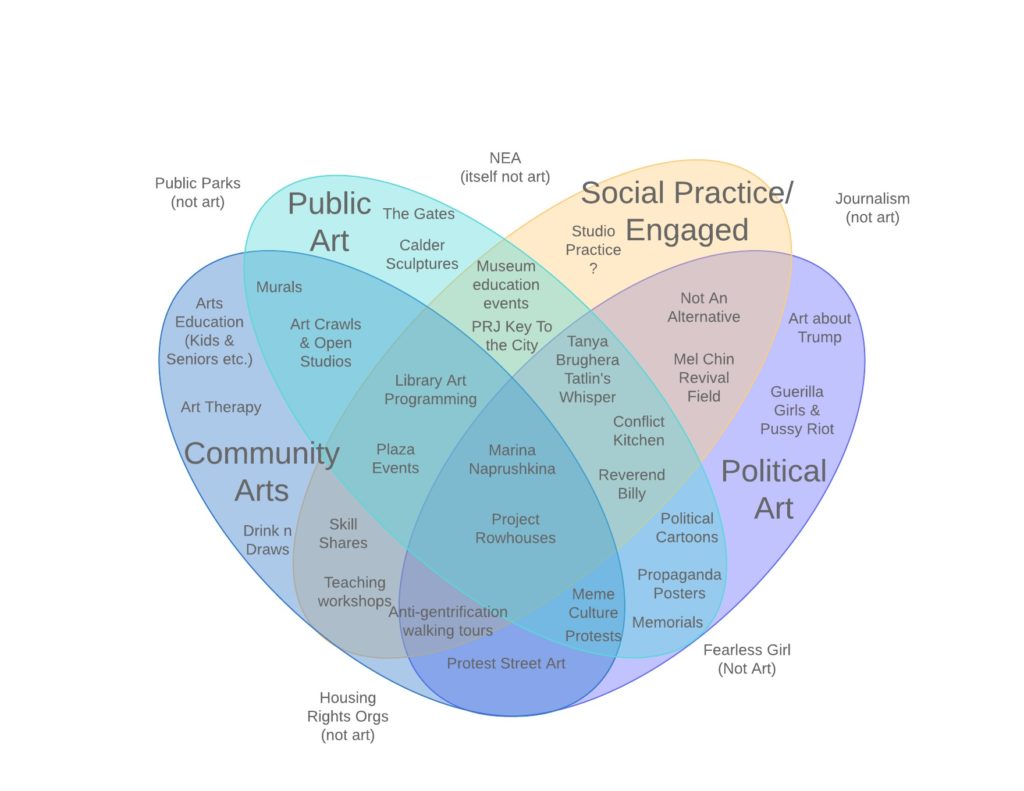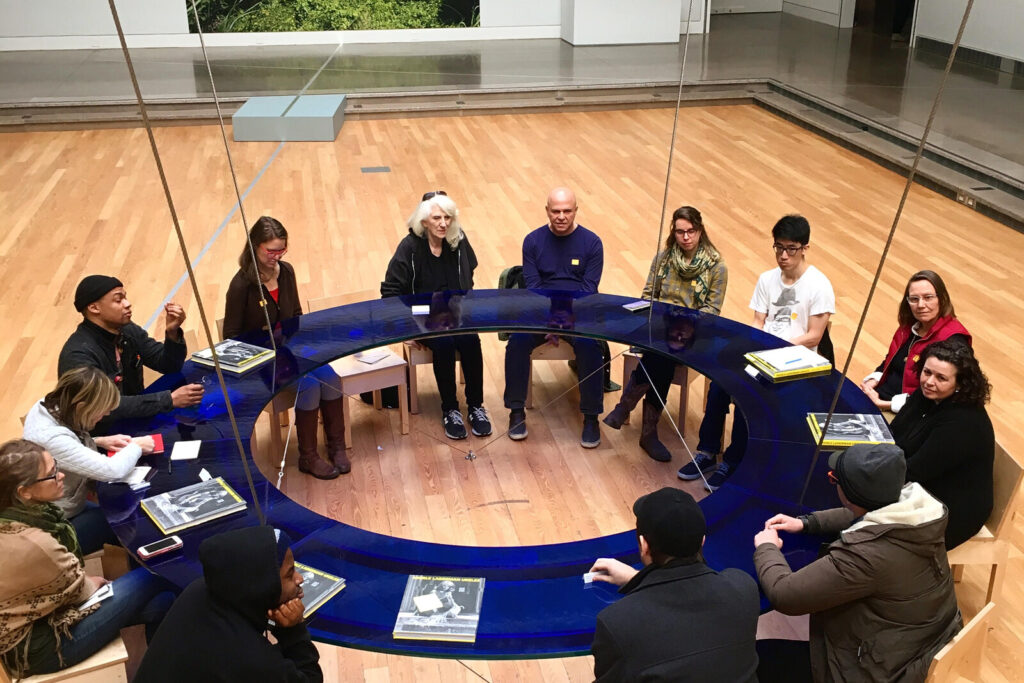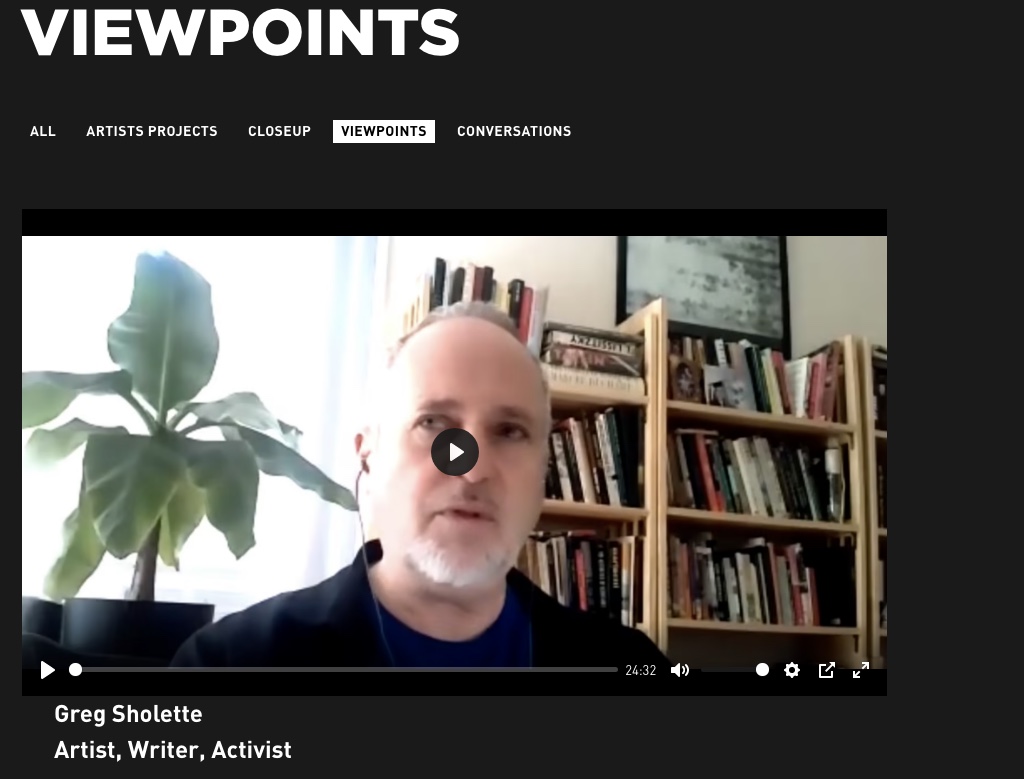__________________________________

__________________________________
History & Theory of Socially Engaged Art
__________________________________
__________________________________
ARTS 777 – ARTH 505/310 – ARTH 7453 – EES 79903
Fall 2021
Mondays 6- 8 PM
Sholette, Gregory instructor
Email: gsholetteSTUDIO@gmail.com
** Syllabus and its content might be
changed, online site is latest version.
*** A copy of the basic syllabus is available here: CLICK
An increasing number of artists, curators, and critics have recently turned their energies toward a new type of participatory socially engaged art making. What had previously been marginalized is now gaining more mainstream attention, with a new prominence in museums, biennials, but also on the streets and other public spaces. Even the New York Times has hailed the emergence of this tendency as “social practice art.” The aim of this seminar is to survey, critique and historicize the theory and practice of social practice art as well as activist, interventionist, public, participatory and community based art operating within and across fields such as performance, urban studies, environmental science and other socially engaged disciplines. The class will focus on such questions as: Why is it useful, even necessary, to understand the history and theory of social practice art? Where should we look to find the historical roots of social practice art? Are these within the history of art, or external to it, or crossing a line between two spheres of cultural interpretation and understanding? And what is the “social”? In an increasingly privatized society how do we define and operate within a concept of the public sphere? And how are both mainstream and alternative types of cultural institutions responding to the increasing interest in socially engaged art by emerging artists? Through lectures, readings, discussions and student research presentations we will seek to position socially-engaged visual culture and the shifting role of the artist within an historical, ideological, and critical framework. If possible, guest speakers and offsite visits will also be added as available.
Expectations
(* see below for more details)
1.) Generate Min/ one question for every guest, upload to shared doc. each week.
2.) You need to present what you’re working on to the class live or on live-zoom.
3.) This presentation is short, about your ongoing research project, for feedback.
4.) BUT, if you decide to write a BOOK REVIEW, please find instructions below.
5.) End of semester (by 12/20) I need a footnoted document that includes:
- An overview of the project incorporating feedback from presentations
- Status of work in progress and future trajectory
- Citations and/or References for your research
_________
_________
THE SYLLABUS
August 30—Introductions & Overview of course
–Some origin stories about socially engaged art
Readings:
Pablo Helguera – (excerpt) Education for Socially Engaged Art
Grant Kester – Eyes of the Vulgar
_________
Sept 13 – A Conversation with Chloë Bass (via zoom from St. Louis)
Reading: Public Art as an Invitation Towards Abolition
_________
Sept 20 Lucy R. Lippard (zooming from New Mexico)
Please email Prof 2 questions for our guest by Saturday evening, Sept. 18th
Readings:
The road to Galisteo: Arts writer, critic, and activist Lucy Lippard
Lucy Lippard on Trading Conceptual Art for Environmental Activism
Six Years: The dematerialization of the art object from 1966 to 1972
2018 interview with Lucy R. Lippard in the Reina Sofia museum in Madrid, Spain discussing her transition from writing on the work of Eva Hesse to Conceptualism and the rise of feminist art including the c0-founding of Heresies (1977) and Political Art Documentation/Distribution (1979) and Artists Call against US Intervention in Latin America (1984).
_________
Sept 27 Suzanne Lacy (in-person at Queens Museum)
Reading: Sharon Irish. Book Excerpt – Suzanne Lacy: Spaces Between
Please email Prof 1 question for our guest by Saturday evening, Sept. 25
DIRECTIONS and Car-Pooling List for Queens Museum
Picnic Dinner after (approx 7:30) weather will be 63 f in the evening.
_________
_________
Oct. 4 Josh MacPhee at Interference Archive, (meet 314 7th St. Brooklyn)
Reading: IA: Building a Counter-Institution in the USA
Please add one question for our host to the shared doc by Sunday evening, Oct. 3.
_________
_________
Oct. 18 Raquel Ermida & 1990s Portuguese art collectivism, (location TBD)
Reading:
Cristina Pratas Cruzeiro “Art with Revolution! Political mobilization in artistic practices between 1974 and 1977 in Portugal”
Additional Reading:
Stimson & Sholette “Collectivism After Modernism” Introduction PP 1-15 (U. Minneapolis 2006)
The Rise of Porto’s Art Collectives and the Birth of Democratic Collaboration and Organizing over Fifteen Years of Everyday Cultural Practice: My investigation documents and analyzes approximately 40 artists’ collectives that emerged in Porto, Portugal between approximately the late 1990’s and 2015, with a particular focus on why this phenomenon gave rise to a new type of dynamic, egalitarian organizing amongst artists that was previously missing within the sphere of the visual arts. This horizontal collectivism led in turn to new models of citizenship and participatory democracy. Nevertheless, there are precedents for some aspects of this phenomenon, especially in relation to Portugal’s relatively recent deposition of forty-eight years of dictatorial rule in 1974. We defend that the principles of collaboration, cooperation and the call for citizens to have a more active participation in society have its origins in the revolutionary process that was preceded by a leftist military coup d’état which overthrew the authoritarian regime. At the time, artists played an important role in the construction and dissemination of the democratic ideas that were lately set forth in the Portuguese Constitution of 1976. The growing neoliberalization of democracy and the emergence of the first Portuguese far-right wing party 50 years after the end of dictatorship bring up the questions of how artists in contemporary Portugal read the constitutional proposal of engaging in a more active citizenship through artistic creation and what can be the political potential of day-to-day group practices in producing inventive and inspiring new modes of living citizenship beyond the sphere of artistic culture.
________
Oct. 25 Avram Finkelstein, curator of “OMNISCIENT: Queer Documentation in an Image Culture,” (meet at Leslie Lohman Museum of Art, Manhattan)
Readings:
Archive Magazine (2020) OMNISCIENT exhibition essay, pp 44-51 (pdf pages 23-26) (200116-LLM-AR68-ALL-Final-Spreads.)
Archive Magazine (2017) essay for FOUND, pp 3-7, (AR60_web_SPRING_2017.) OMNISCIENT was meant as a further exploration of the questions I raised in my previous LLM exhibition, FOUND:Queer Archaeology; Queer Abstraction about queer representation in the image culture of late capitalism.
NYT review of FOUND, that discusses being an out artist in the Middle East. It mentions Omar Mismar, the Lebanese artist I included in both shows.
NYT review that contextualizes the museum and the exhibition FOUND.
Brooklyn Rail article about queer abstraction. Both FOUND and OMNISCIENT address the question of queer representation, and pose queer abstraction and documentation as strategies for dealing with corporeality.
_________
Nov 1 Presentations: first HEROIC project by A Pollicini
_________
Nov 8 Daniel Tucker – (zoom from Philly)
Reading: Tucker, Communiversity: Inside and Outside Art Education
_________
Nov 15 Floor Grootenhuis [meet earlier in day Raper Laboratory, Hunter College]
Readings:
A. M. Brown (2017). Emergent strategy: Shaping change, changing worlds. Chico, CA : AK Press.
What’s gotten into you? (AUDIO from RADIOLAB)
_________
Nov 22 Jeff Kasper at the Clemente Center
Reading: PRACTICING DISTANCE
Nov 29 – 2nd batch of Presentations
_________
Dec 6 Dread Scott (ZOOM)
Reading: Artist Dread Scott’s First NFT
_________
Dec 13 – 3#rd and Final Presentations
Dec 20 Wrap up – Eat
_________
NOTE School is closed:
Monday, September 6th (Labor Day)
Monday, October 11th (Columbus Day)
Possible Sites for Presentations:
Weeksville Heritage Center – Brooklyn
The Graduate Center
Trump Tower ground floor (vintage maga accessory shopping optional)
__________________________________
Learning Goals & Course Outcomes
# Develop theoretical and historical knowledge of emerging social practice art field.
# Explore and debate complexities, paradoxes and possibilities of socially engaged art.
# Engage in original research related to social practices and individual student projects.
# Foster an environment for investigating cross-disciplinary exchange and critical thinking.
# Acquire working knowledge of seminal texts relevant to this field and in relation to the broader background of art history.
Five Research Questions this Course will Attempt to Answer
1. The definition question: How does social practice differentiate
itself from social service ? Is this important to resolve? What kind of
questions and assumptions arise if we seek to make social practice its own
distinct artistic method? And what sort of questions and assumptions arise if we do not differentiate it from art or from say, community work, environmental activism, urban reform, or social justice advocacy?
2. The institutionalization/academic question: Is social practice art
radically opposed to mainstream art and culture? Is it rejuvenating it? Or is
it being co-opted by it? How can we frame this question to get beyond simple answers and find a more engaging and useful thesis from which to work?
3. The context question: Who is a social practice artist and what sort
of “agency” does she or he have in a world of hyper-surveillance and economic ? And who is such work made for and why? Is it global or local, white or black, academic, or populist? Does it have a specific historical framing? Is it logical to assume it will be part of future arts academic curricula and how will this alter the study of art and of art criticism, history, curating, etc..?
4. The “aesthetic” question: Is there a social practice art-aesthetic or form or repertoire of forms specific to this kind of work? If yes, what kind of questions do we need to ask in order to investigate what this particular aesthetic consists of? And if there is no such thing as a social
practice aesthetic how will this “lack” impact the practice of social practice
art if at all?
5. The organizational question: the practice of social practice art, as opposed to many other types of artistic practice, inevitably involves processes of organization, administration, and self-governance. What precedents exist regarding this conjoining of artistic and organizational needs and goals, and does a distinctive hybrid of some type emerge from this entanglement?
& Five Evaluative Concepts for determining the presence of a “work of art” (these might be useful for your research and projects):
1. INTENTION – the artist means for the project [the work/performance/event/etc…] to be grasped as a work of art
2. ART-CENTRICITY – artistic concerns or activities are a central concern of the project including para-fictionality and pre-figuration.
3. INSTITUTIONALITY – the project is readable within the discourse and power relations of art industry/art history, criticism & theory
4. WORLDING / WORLD BUILDING – the project’s methods draw upon, explore, and/or expand a uniquely artistic world view or approach to research or expression or making.
5. TRESPASSING – Rick Lowe’s term for mimicry & border-crossing visual art carries out into other disciplines, parts of society or the world.
Assignments and Expectations
A. Generate at least one question for each week’s guest based upon readings and your own research.
B. Make one short (ten minute) presentation during the course of the semester in consultation with instructor.
C. Submit a Final Project last 2 – 3 weeks of semester (two options):
1. Create a performance, situation, exchange for the class tbd.
OR
2. Write a review of a book, extended essay tbd. * This can be the basis of
your short presentation. *
Grading and Requirements
You are responsible for reading and discussing all assigned texts. Attendance is essential due to the participatory nature of this course. All students are expected to come to class prepared and on time.
If a problem arises regarding attendance or assignments, you should
contact me as soon as possible. Missing a class does not mean that you are excused from an assignment. In short, participation and attendance figure heavily in your overall evaluation and grade.
Evaluation:
30% Participation in class
30 % Class presentation
40% Final Project
More About the Final Project Options:
1.) an artistic work based on research and knowledge gained during our seminar. This project needs to be accompanied by documentation of research in the form of a short description of the piece and a bibliography of research references (that must include some written material, three minimum, but can also cite art works, musical compositions, performances etc…)
2.) A second option is to write a book review of 1500 – 2000 words focused on a book or extended academic essay related to the class in general, or about a particular practitioner of socially engaged art. Your review should consist of 1500 – 2000 words and accomplish these objectives: 1.) Summarize why the book/essay is important including what its arguments are and how it relates to socially engaged art. 2.) How does this particular book contribute to the field of art, socially engaged practices, improving society? 3.) Does the author(s) achieve what they set out to do and does their argument make sense? Additional notes: if you quote the author be sure to add the page number of the citation inside (parentheses). For more details see: BOOK REVIEW GUIDELINES, and be sure to use this format below for the title of your review:
Title and Subtitle [Upper case and boldface]. Author(s) or Editor(s). Place of Publication: Name of Press, Date. pp.[both Roman and Arabic numerals]; maps, diagrs., ills., notes, bibliog., index [include these as appropriate].
Geographies of Mars: Seeing and Knowing the Red Planet. K. Maria D. Lane. Chicago, IL: University of Chicago Press, 2011. xiii and 266 pp., maps, photos, diagrams, illus., notes, bibliog., index.
__________________________________
__________________________________

__________________________________
Additional (Optional) Readings:
__________________________________
Global Conceptualism (Intro Only)
_______________s___________________
Michael G. Birchall, Socially engaged art in the 1990s and beyond
—
SPECIAL INSERT: COVID-19 READINGS:
“The Corona Reboot” by Ian Alan Paul
“Coronavirus Propagations” by Jonas Staal
—
Counter Critiques of Social Practice Art
Ben Davis in International Socialist Review
Notes about Joseph Beuys, Gregory Sholette (2018)
—
Art and Labor and Feminism:
M. UKELES MANIFESTO PDF Download
The labor-oriented performance art of Marty Pottinger
Interview with Marty Pottinger
Visit the Guerilla Girls website: https://www.guerrillagirls.com/
—
From Tom Finkelpearl:
Finkelpearl, “A Cooperative Animal”
Introduction to “What We Made,” by Tom Finkelpearl
Tom Finkelpearl interviews Mierle Laderman Ukeles from his book Dialogues in Public Art.
—
SPQ’s Urbanism/Transforming Corona Plaza Project 2012:
http://www.streetfilms.org/queens-corona-plaza-a-community-place-rises/
Transforming Corona Plaza Studio Presentation
Sholette interview with T. Cruz “Urban Policy & DNA”
Article about Immigrant Movement International (IMI)
The Collective Making of ABC NO RIO, Nandini Bagchee
—
On Theaster Gates:
John Colapinto, “The Real-Estate Artist,” The New Yorker, Jan. 20, 2014https://www.ted.com/talks/theaster_gates_how_to_revive_a_neighborhood_with_imagination_beauty_and_art?utm_campaign=tedspread&utm_medium=referral&utm_source=tedcomshare
Nate Bert, “From Theaster Gates to Assemble: is there an art to urban regeneration?”
Gary Younge, “Theaster Gates, the artist whose latest project is regenerating Chicago.”
Sholette, “Art After Gentrification.”
—
On REPOhistory:
1992 REPOhistory sign project catalog
Overview of REPOhistory 1989-2000
Online documentation of REPOhistory signs (select)
Fordham Urban Law Journal about 1998 REPOhistory project
REPOhistory slide presentation with notes: click here
—
Additional Resources:
PPT LECTURE: A BRIEF HISTORY OF INSTITUTIONAL CRITIQUE
General history of art collectivism timeline
The Tate’s Definition of Socially engaged art practice
Identity and Political Art as Mainstream Culture
Proletarian Fashion Dolce & Gabbana (seriously?)
______________________________________________
______________________________________________
CUNY Boiler Plate:
CUNY
POLICY ON ACADEMIC INTEGRITY
The Policy on Academic Integrity, as adopted
by the Board is available to all candidates.
Academic Dishonesty is prohibited in The City University of New York and
is punishable by penalties, including failing grades, suspension, and
expulsion. This policy and others related to candidates’ issues are available
to you at: http://qc.cuny.edu/?id=IUHC
USE
OF CANDIDATE WORK
All teacher education programs in New York
State undergo periodic reviews by accreditation agencies and the state
education department. For these
purposes, samples of candidates’ work are made available to those professionals
conducting the review. Candidate
anonymity is assured under these circumstances.
If you do not wish to have your work made available for these purposes,
please let the professor know before the start of the second class. Your cooperation is greatly appreciated.
REASONABLE
ACCOMMODATIONS FOR CANDIDATES WITH DISABILITIES
Candidates with disabilities needing academic
accommodation should: 1) register with and provide documentation to the Special
Services Office, Frese Hall, Room 111; 2) bring a letter indicating the need
for accommodation and what type. This should be done during the first week of
class. For more information about services available to Queens College
candidates, contact: Special Service Office; Director, Miriam Detres-Hickey,
Frese Hall, Room 111; 718-997-5870 (Monday – Thursday 8:00 a.m. to 5:00 p.m.
& Friday 8:00 a.m. to 4 p.m.).
______________________________________________
______________________________________________

